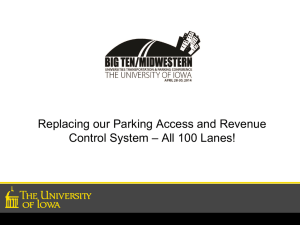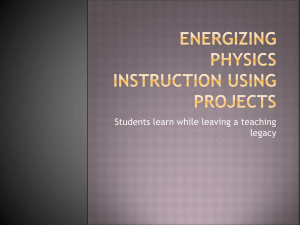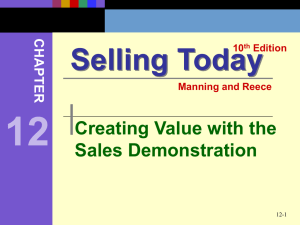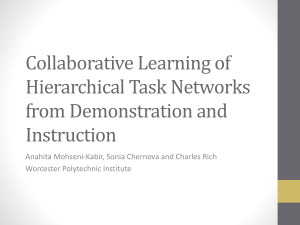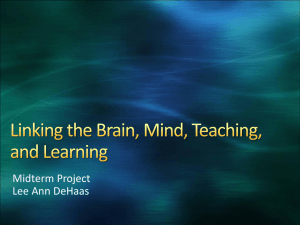Learning From Demonstrations, Time warping, cool applications
advertisement
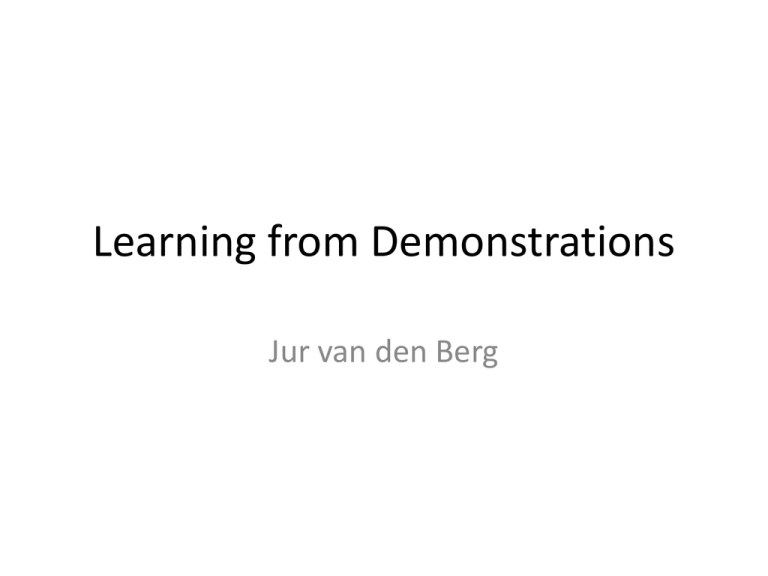
Learning from Demonstrations Jur van den Berg Kalman Filtering and Smoothing • Dynamics and Observation model x t 1 Axt w t , w t ~ N (0, Q ) yt Cxt vt , v t ~ N (0, R ) • Kalman Filter: – Compute X t | Y0 y 0 , , Yt y t – Real-time, given data so far • Kalman Smoother: – Compute X t | Y0 y 0 , , YT y T , – Post-processing, given all data 0tT EM Algorithm x t 1 Axt w t , w t ~ N (0, Q ) yt Cxt vt , v t ~ N (0, R ) • Kalman smoother: – Compute distributions X0, …, Xt given parameters A, C, Q, R, and data y0, …, yt. • EM Algorithm: – Simultaneously optimize X0, …, Xt and A, C, Q, R given data y0, …, yt. Learning from Demonstrations • Application of EM-algorithm • Example: – Autonomous helicopter aerobatics – Autonomous surgical tasks (knot-tying) Motivation • Learning an ideal “trajectory” of system • Human provides demonstrations of ideal trajectory • Human demonstrations imperfect • Multiple demonstrations implicitly encode ideal trajectory • Task: infer ideal trajectory from demonstrations Acquiring Demonstrations • Known system dynamics (A, B, Q) • Observations with known sensors (C, R) – Inertial measurement unit – GPS – Cameras x t 1 Axt Bu t w t , w t ~ N (0, Q ) yt Cxt vt , v t ~ N (0, R ) • Use Kalman smoother to optimally estimate states x along demonstration trajectory Multiple Demonstrations • D demonstration trajectories of duration Tj j xt j dt j u t j 1, , D t 1, , T j • Hidden ideal trajectory z of duration T* x t zt u t t 1, , T Model of Ideal Trajectory • Main idea: use demonstrations as noisy observations of hidden ideal trajectory • Dynamics of hidden trajectory z t 1 A 0 B zt w t , I Q w ~ N (0, 0 t 0 ) N • Observation of hidden trajectory d 1t I z t st , d D I t S 1 st ~ N (0, 0 0 0 0 0 0 ) D S Inferring Ideal Trajectory • Dynamics model: Parameter N controls smoothness; A, B, Q known • Observation model: Parameters S encode relative quality of demonstrations • Use EM-algorithm with Kalman smoother to simultaneously optimize z and S (and N). • Initialize S with identity matrices Time Warping • But, this assumes demonstrations are of equal length and uniformly paced • Include Dynamic Time Warping into EMalgorithm • Such that demonstrations map temporally Time Warping • For each demonstration j, we have function tj(t) • Maps time t along z to time tj(t) along dj • Adapted observation model: d11 I t (t ) z t st , d D I t D (t ) S 1 s t ~ N (0, 0 0 0 0 0 0 ) D S Learning Time Warping • tj(t) is (initially) unknown • Assume (initially): – T* = (T1 + … + TD) / D – tj(t) = (Tj / T*) t • Adapted EM-algorithm: – Run Kalman smoother with current S and t – Optimize S by maximizing likelihood – Optimize t by maximizing likelihood (Dynamic Time Warping) Dynamic Time Warping • Match demonstration j with z • Assume that demonstration moves locally – twice as slow as z – same pace as z – twice as fast as z • Dynamic Programming to find optimal “path” • Cost function: likelihood of d t j (t ) z t s t , j j s t ~ N (0, S ) Example: Helicopter Airshow • Thesis work of Pieter Abbeel • Unaligned demonstrations: – Movie • Time-aligned demonstrations: – Movie • Execution of learnt trajectory – Movie Example Surgical Knot-tie • ICRA 2010 Best Medical Robotics Paper Award • Video of knot-tie Conclusion • Learning from demonstrations • Includes Dynamic Time Warping into EM-algorithm
